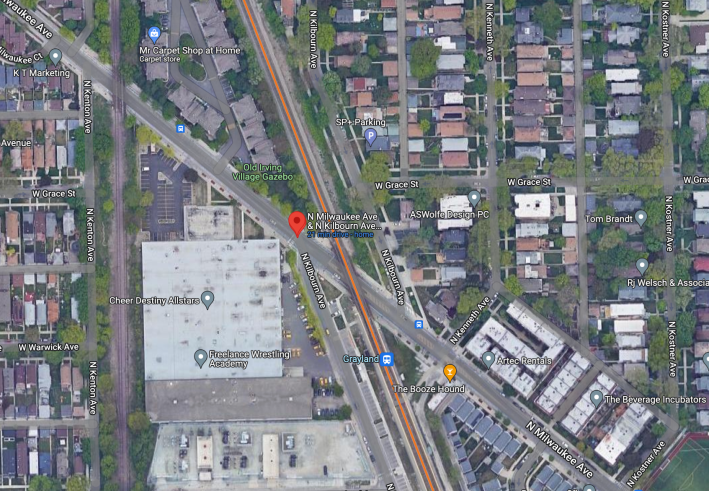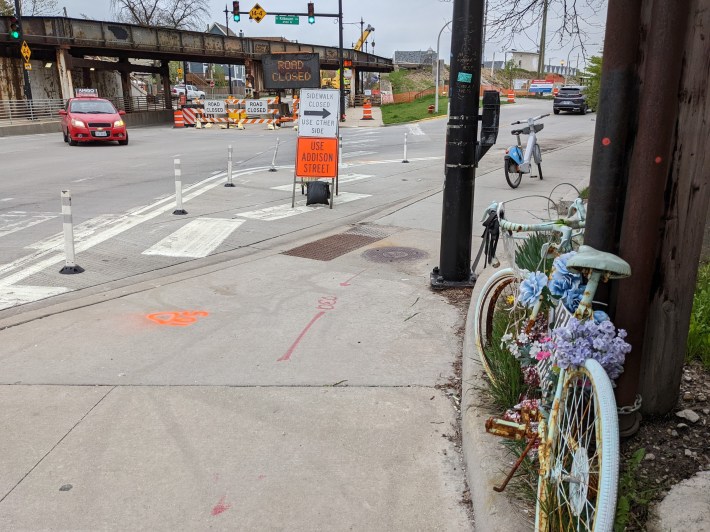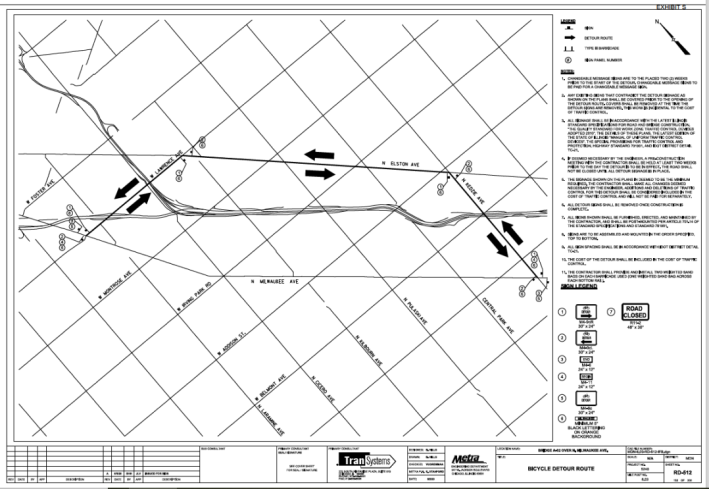Last Wednesday night, May 4, delivery driver Phil Pinkawa fatally struck barista Nick Parlingayan, 22, on his bike on Milwaukee Avenue, just past Kilbourn Avenue and the Grayslake Metra stop in the Irving Park community. Pinkawa fled the scene and waited until Saturday night to turn himself in to police. He was charged with one felony count of failure to report a crash resulting in a death, and is currently out bail with a court date this Thursday.
Milwaukee Avenue is Chicago's busiest bike street. As of 2017, in the warmer months, up to 5,000 people were biking on Milwaukee a day, exceeding the number of motor vehicles at some locations during rush hours. But the street has also seen more than its fair share of cycling deaths, with at least five people fatally struck by drivers on the avenue within the last 20 years.
Parlingayan’s death was the second bike fatality near Milwaukee/Kilbourn within about two and a half years. On November 6, 2019, a dump truck driver failed to yield while turning south from Milwaukee onto Kilbourn, crushing school guidance counselor Carla Aiello, 37, as she cycled southeast in the bike lane.
After bike advocates protested for safer conditions, the city installed a sidewalk extension with paint and flexible plastic posts at the northwest corner of Milwaukee/Kilbourn, where Aiello was struck. Unfortunately, the still-wide turning radius onto Kilbourn continues to encourage drivers to continue traveling at high speeds around the corner, a habit the paint and posts have done little to nothing to discourage, as shown by recent video footage of several drivers whipping around the corner so fast that they veer into the oncoming lane.
Parlingayan's death has once again prompted residents to demand this dangerous intersection be made safe for cyclists and other road users. Conditions have been made more perilous recently by a lack of pedestrian and bicyclist accommodations during a $32 million Canadian Pacific Railroad bridge rehab project.

The southeast-bound lane of Milwaukee Avenue is currently closed for the construction project where it passes under the rail line, which is used by Metra's Milwaukee District North route. Jersey barriers on the northwest bound side constrict the lane so that drivers are forced to travel in the painted bike lane. Pinkawa struck Parlingayan as he was biking northwest on Milwaukee, just north of the underpass.

Bish Krywko, who lives in far-north-suburban Round Lake and works near the crash site, was outraged to hear that a driver killed a second person on a bike at the same intersection. He wrote a letter to Mayor Lori Lightfoot, local alderman James Gardiner (45th), the Chicago Department of Transportation, Metra, the construction company, and the Active Transportation Alliance arguing that this tragedy might have been prevented if bicyclists been rerouted to the sidewalk under the underpass, creating actual separation between bikes and vehicles. "I am reaching out today to seek proactive action to avoid another tragedy."
[Content warning: The following paragraphic contains a graphic description of a bike fatality.]
Krywko wrote that he was able to view footage of the Parlingayan crash from the security camera of a nearby business, and he described what he saw.
I felt compelled to write and share with all who care for the life of another. This young man did not fall off his bike after getting bumped by a car, as was reported [by police]. The gut-wrenching fact is he was hit so hard that he and his bike were dragged over 50 feet, with sparks flying, until they both broke free from the car, he hitting the ground and sliding about 30 feet before his lifeless body came to a stop behind a parked car. The driver of the hit-and-run vehicle never slowed down once. And had Parlingayan stood any chance of survival his odds were decreased dramatically by the how long it took the first emergency vehicles to arrive, an unbelievable 14 minutes.
Krywko told Streetsblog via email that although the moment of impact wasn't captured in the video, it was clear the driver was “traveling quite fast and continued to do so even after the collision.”
Due to the closure under the viaduct, all southeast-bound road users, including drivers and people biking, are currently directed to turn right onto Kilbourn. In an email to Streetsblog, Northwest Side resident Pete Czosnyka pointed out that the marked detour route for southeast-bound bike riders directs them to pedal a mile east on Lawrence Avenue to Elston Avenue, and then ride the same distance south on Kedzie avenue back to Milwaukee. That's boondoggle Czosnyka rightly observes “no one would do,” and refers to as “a lazy effort made to just get something on paper.”

Czosnyka made a similar recommendation as Krywko: diverting bike riders from both directions to the north-side sidewalk under the viaduct, “even if they had to walk the bike under the bridge.” It’s worth noting that many bicyclists already move onto sidewalks when passing under Chicago’s numerous viaducts that cause the road to narrow to a single, shoulder-less lane with a high curb on the righthand side – technically breaking the law for a few hundred feet in the interest of self-preservation.
Both Czosnyka and Krywko called for desperately needed traffic-calming around the intersection. Krywko noted an absence of "Work Zone" and reduced speed limit signs and suggested installing speed cameras near the intersection. After Aiello's death, more than 600 residents signed a petition requesting speed cameras, and Alderman Gardiner promised them but has not yet delivered. Czosnyka suggested speed bumps (which CDOT typically won't install on main streets) or other design-based measures.
Which researching this subject, I both biked and borrowed a friend’s car to drive past the site of Aiello’s and Parlingayan’s deaths. During my journey in the car, much of which was at a rush-hour crawl, more than one driver hopscotched to the right, using the bike lane to blow past other vehicles at a dangerous speed and turn right at an intersection ahead, or merge back into traffic a few cars forward. As a motorist, being surrounded by this kind of driving is deeply irritating. As a bicyclist, it’s terrifying.
In his letter, Krywko noted that he and others had witnessed southeast bound vehicles going under the viaduct on the northwest bound lane, risking head-on collisions with other drivers, and suggested clearer signage about the street closure including large “Wrong Way” signs.
The road closure signs and barricades in place seemed clear enough to me and, considering driver behavior in the last year, it’s hard to say if such deeply reckless behavior is the result of confusion or impatience. What is certain is that with bicycle fatalities on the rise. Especially on roads designated as primary bike routes, greater protection for people on bicycles is imperative, such as robust protected bike lanes with concrete curbs, Jersey barriers, or rigid bollards. We also need well-planned accommodations around construction projects that further aggravate traffic congestion and increase the proximity of drivers and bike riders. Paint and posts are not enough.



